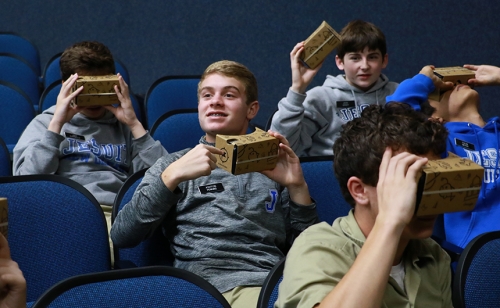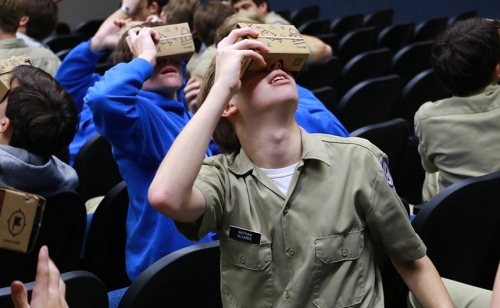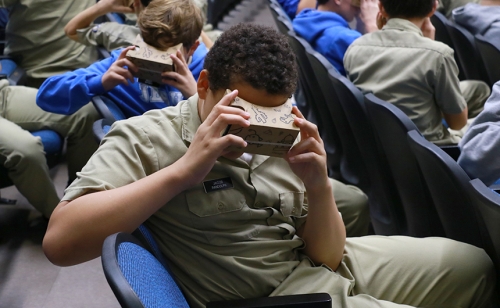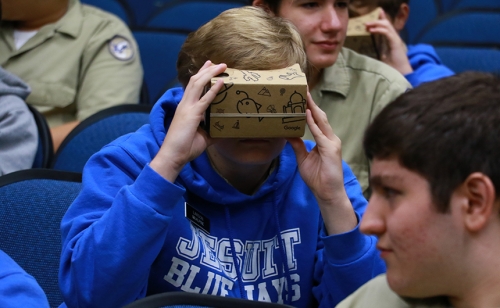Blue Jays Take Virtual Field Trips Around the World

David Hart looks through a Google Cardboard viewer to take a virtual field trip to Barcelona with his Spanish class. Click photo to view gallery.
More than 200 Blue Jays in Spanish and social studies classes went on field trips across the world, travelling hundreds of thousands of miles in a single day – all without ever packing a bag, getting on a plane, or even leaving the auditorium. The students took the international virtual trips courtesy of a new technology called Google Expeditions.
Expeditions allows teachers to immerse their classes in worldwide experiences and bring abstract concepts to life. The virtual field trips take place using Google Cardboard, a virtual reality viewer made almost entirely of actual cardboard. The viewers have a smartphone placed inside them that displays a virtual reality panorama of the location of your choice.
Spanish teacher Ms. Nilda Rivera learned about the Google Expedition Pioneer Program through an online professional development seminar she was completing and inquired about bringing it to Jesuit – and, in turn, helped Blue Jays be the first in the state, and among the first around the world, to experience the technology.
View Photo Gallery of the Blue Jays’ Google Expedition Virtual Field Trips
With the viewer, Blue Jays were able to explore virtual reality panoramas — 360° photo spheres, 3D images and video, and ambient sounds.
Using a handheld tablet, teachers selected a destination and the Cardboard viewers allowed the entire classroom to jump there automatically. Teachers lead the adventure by selecting points of interest.
Students in Spanish classes were able to explore several Spanish-speaking locales, such as Machu Picchu, Barcelona, Mexico City, and the Galapagos Islands, among others.
“I’ve never been able to travel internationally, so being able to see the culture and the architecture of places outside of America was incredible,” said junior Ean Neyrey. “When we were in Machu Picchu, the stones looked like they were right there. It felt like you could reach out and touch them.”
Spanish teachers Mr. Andrew Dykema, Ms. Nilda Rivera, Ms. Deika Bustamante, and Mr. Matt Austin used the activity to incorporate the AP Spanish theme of “Beauty and Aesthetics” into their curricula.
Spanish classes spent the day before their Expedition discussing the definitions of beauty and aesthetics. Students completed classwork that helped them compare some of the most famous architectural works across the world, discussing what they had in common and what made them beautiful and culturally significant.
That class activity primed them for the discussion they had while on their international Expeditions.
“I’ve wanted to travel the world for a long time, and now getting a glimpse of it with Google Expeditions, it makes me want to go even more,” said junior Alex Welsh. “I want to see Machu Picchu in person and actually be able to touch the ruins, to go to Barcelona for real, and see the Galapagos Islands – all these scenic places we visited virtually today – I want to go in person now.”
The teachers were grateful to be able to lead the virtual journeys and show their students places they might not be able to visit otherwise.
“Some students are lucky enough to be able to travel with their families, or have taken international service trips, but most Blue Jays haven’t been able to go to many of the Spanish-speaking countries,” said Dykema. “We’re grateful to be able to experience this technology. It is a really cool way to be able to visit these places, explore the terrain, and experience the culture with the entire class.”
Created with input from The Wildlife Conservation Society, PBS, the American Museum of Natural History, the Planetary Society, and the Palace of Versailles, there are more than 100 Expeditions locations across the globe. Each location provides a unique way for teachers to integrate virtual reality into their classes.
Blue Jays in two social studies classes – Mr. Ron Rossi’s American History class and Mr. Wade Trosclair’s Western Civilization class – were able to take virtual trips of their own.
“I could always show them a photo, but to be able to put yourself in the position and have a 360° view, is great for the class,” said Trosclair. “We saw the Egyptian pyramids [at Giza] and the students were noticing the visitor center. So you feel like you’re right there – it really brings the history lesson to life.”
Trosclair says after working with the technology, he sees how he could incorporate it into future lesson plans.
“When we discuss the Palace of Versailles and Louis XIV, we talk about how the palace played such a huge role in Louis XIV becoming a powerful king by trying to awe his guests,” said Trosclair. “We could actually go into the Hall of Mirrors, where three major events in history happened. And [the students] could see it up close and feel like they are there, stepping back into history.”
Google plans to introduce more than 2 million Cardboard viewers in the near future.
For the Jesuit teachers and students who participated in the pilot program, the sooner, the better.
Videos
Galleries
Google Expeditions Virtual Field Trips, Dec. 1, 2015
-
 David Hart looks through the Google Cardboard viewer.
David Hart looks through the Google Cardboard viewer. -
 Shane Lanson marvels at the The Great Sphinx of Giza.
Shane Lanson marvels at the The Great Sphinx of Giza. -
 Mr. Trosclair points out places of interest while on a field trip to the Pyramids at Giza.
Mr. Trosclair points out places of interest while on a field trip to the Pyramids at Giza. -
 Sean Seghers answers a question Mr. Trosclair posed to the class.
Sean Seghers answers a question Mr. Trosclair posed to the class. -
 Ashton Perkins answers a question Mr. Trosclair posed to the class.
Ashton Perkins answers a question Mr. Trosclair posed to the class. -
 Colin Meyer and Daniel Passant look up at the sky while in Venice.
Colin Meyer and Daniel Passant look up at the sky while in Venice. -
 Reece de Boisblanc and Freddie Washington explore Rome on their Expedition.
Reece de Boisblanc and Freddie Washington explore Rome on their Expedition. -
 While touring the Colosseum, Trosclair points out things they discussed in previous class lessons.
While touring the Colosseum, Trosclair points out things they discussed in previous class lessons. -
 Mr. Wade Trosclair '07 guides his class on a tour of Rome.
Mr. Wade Trosclair '07 guides his class on a tour of Rome. -
 Along the tour, Mr. Rossi points out several places of historical interest.
Along the tour, Mr. Rossi points out several places of historical interest. -
 Mr. Ron Rossi guides his American History students through a tour of Philadelphia.
Mr. Ron Rossi guides his American History students through a tour of Philadelphia. -
 Mr. Ron Rossi guides his American History students through a tour of Philadelphia.
Mr. Ron Rossi guides his American History students through a tour of Philadelphia. -
 The Cardboard viewers give students the ability to zoom in and out, getting a true 3D picture of the location.
The Cardboard viewers give students the ability to zoom in and out, getting a true 3D picture of the location. -
 While below the ocean's surface, the Jays look in every direction as they are surrounded by a large school of fish.
While below the ocean's surface, the Jays look in every direction as they are surrounded by a large school of fish. -
 While exploring the Galapagos Islands, Ms. Bustamante takes the Blue Jays under water.
While exploring the Galapagos Islands, Ms. Bustamante takes the Blue Jays under water. -
 Junior Alex Welsh goes on a virtual field trip to Machu Picchu. After the trip he says, “I want to see Machu Picchu in person and actually be able to touch the ruins, to go to Barcelona for real, and see the Galapagos Islands – all these scenic places we visited virtually today – I want to go in person now.”
Junior Alex Welsh goes on a virtual field trip to Machu Picchu. After the trip he says, “I want to see Machu Picchu in person and actually be able to touch the ruins, to go to Barcelona for real, and see the Galapagos Islands – all these scenic places we visited virtually today – I want to go in person now.” -
 Ms. Bustamante explores Mexico City with the students.
Ms. Bustamante explores Mexico City with the students. -
 Nathan Alvarez looks up to a mountain peak from the comfort of his auditorium seat.
Nathan Alvarez looks up to a mountain peak from the comfort of his auditorium seat. -
 Ms. Rivera and Mr. Dykema point out locations for students to explore.
Ms. Rivera and Mr. Dykema point out locations for students to explore. -
 Students were able to look in every direction, exploring the unique terrain of each destination.
Students were able to look in every direction, exploring the unique terrain of each destination. -
 The viewer displays 360 degree views. Jacob Randolph looks at the ground while on a virtual trip.
The viewer displays 360 degree views. Jacob Randolph looks at the ground while on a virtual trip. -
 With more than 100 locations to choose from, Dykema was able to easily move his class from place to place, travelling several hundred thousand miles within one class period.
With more than 100 locations to choose from, Dykema was able to easily move his class from place to place, travelling several hundred thousand miles within one class period. -
 Each "smiley face" on the teacher's tablet represents the location in which a student is looking.
Each "smiley face" on the teacher's tablet represents the location in which a student is looking. -
 When he wants to point out a specific point of interest, Dykema points to a spot on the tablet signified by the circle. Each students' viewer then displays an arrow in the direction the teacher is instructing the class to look, keeping everyone together on the virtual trip.
When he wants to point out a specific point of interest, Dykema points to a spot on the tablet signified by the circle. Each students' viewer then displays an arrow in the direction the teacher is instructing the class to look, keeping everyone together on the virtual trip. -
 Dykema guides his class through Machu Picchu.
Dykema guides his class through Machu Picchu. -
 The class heads out on a virtual field trip.
The class heads out on a virtual field trip. -
 Ms. Deika Bustamante and Mr. Andrew Dykema explore a location on the handheld tablet.
Ms. Deika Bustamante and Mr. Andrew Dykema explore a location on the handheld tablet. -
 Speaking entirely in Spanish, Ms. Nilda Rivera prepares her class for the virtual field trip to several Spanish-speaking countries.
Speaking entirely in Spanish, Ms. Nilda Rivera prepares her class for the virtual field trip to several Spanish-speaking countries. -
 Matthew Latham explores the terrain on the Expeditions trip.
Matthew Latham explores the terrain on the Expeditions trip. -
 Larson McAlpine looks into the Google Cardboard viewer on a "trip" to Barcelona.
Larson McAlpine looks into the Google Cardboard viewer on a "trip" to Barcelona.
